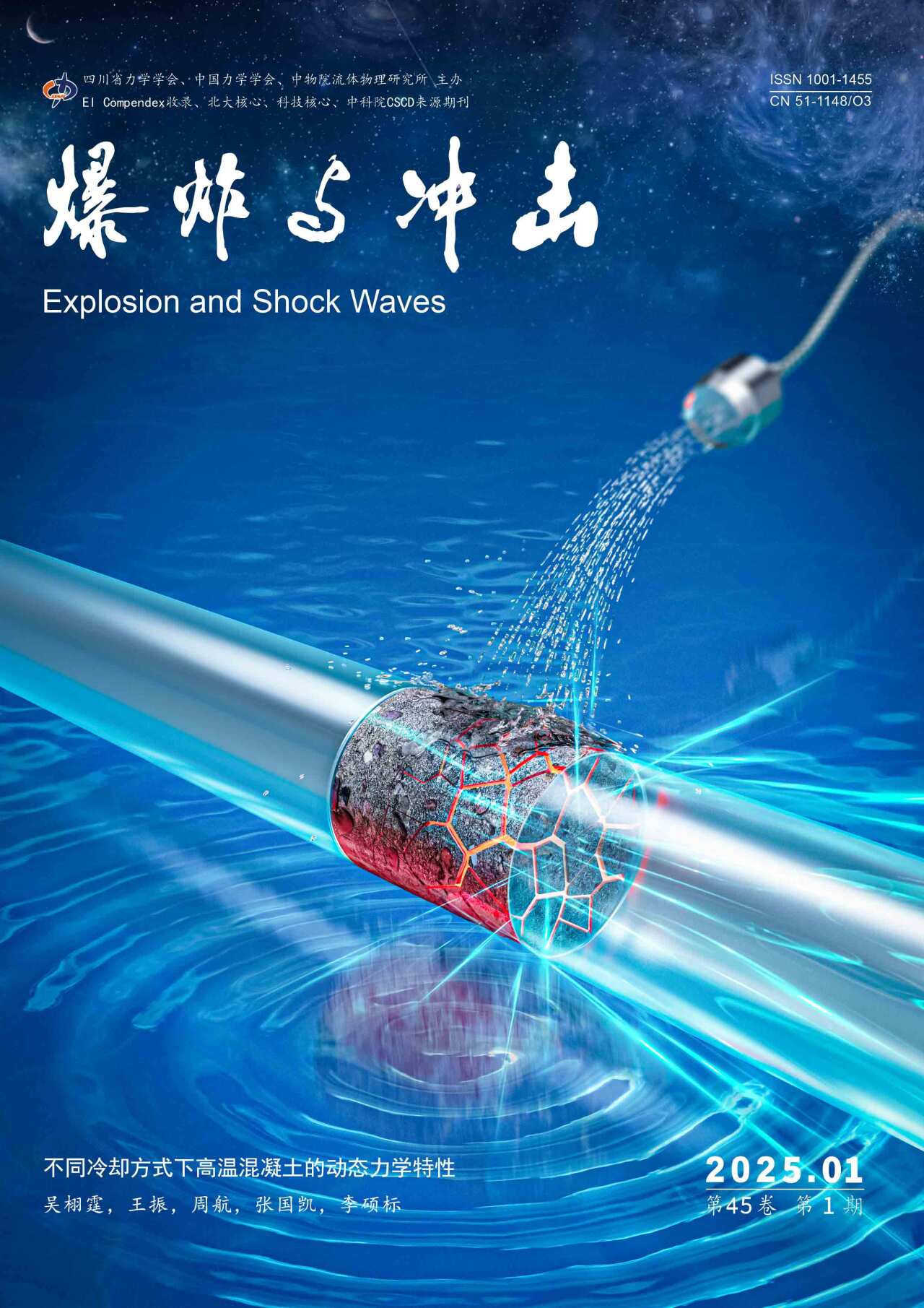| [1] |
江见鲸, 冯乃谦. 混凝土力学 [M]: 北京: 中国铁道出版社, 1991.
JIANG J J, FENG N Q. Concrete mechanics [M]: Beijing: China Railway Press, 1991.
|
| [2] |
JIN L, YU W X, DU X L, et al. Meso-scale modelling of the size effect on dynamic compressive failure of concrete under different strain rates [J]. International Journal of Impact Engineering, 2019, 125: 1–12. DOI: 10.1016/j.ijimpeng.2018.10.011. |
| [3] |
LI S T, WANG W, LIANG S F, et al. Dynamic response of beam-plate composite structure under blast shock wave load during long-term holding [J]. Explsion and Shock Waves, 2022, 42(7): 075103. DOI: 10.11883/bzycj-2021-0495. |
| [4] |
YU Z W, DING F X, LUO J P. Experimental research on mechanical properties of different type of concrete after high temperature [J]. Journal of Safety and Environment, 2005, 5(5): 1–6. DOI: 10.3969/j.issn.1009-6094.2005.05.001. |
| [5] |
WANG K F, XU Q F, LIU T L. Experimental research on mechanical performance of concrete under high temperature and cooled down from high temperature [J]. Construction Technology, 2005, 34(8): 1–3. DOI: 10.3969/j.issn.1002-8498.2005.08.001. |
| [6] |
HAGER I, TRACZ T, NSKA M C, et al. Effect of cement type on the mechanical behavior and permeability of concrete subjected to high temperatures [J]. Materials, 2019, 12(18): 3021. DOI: 10.3390/ma12183021. |
| [7] |
LYU T Q, ZHAO G F, LIN Z S. Experimental study on mechanical properties of long standing concrete after exposure to high temperature [J]. Journal of Building Structures, 2004, 25(1): 63–70. DOI: 10.3321/j.issn:1000-6869.2004.01.009. |
| [8] |
ZHENG Y T, LI Y C, PENG C X. Effect of different cooling methods on mechanical properties of concrete after high temperature [J]. Journal of Water Resources and Water Engineering, 2019, 30(4): 189–194. DOI: 10.11705/j.issn.1672-643X.2019.04.30. |
| [9] |
WANG Z. Experimental study on fire burning damage of high-performance concrete buildings [D]. Chengdu: Southwest Jiaotong University, 2011. DOI: 10.7666/d.y1957672. |
| [10] |
WANG Y T, LIU D S, LI S L, et al. Experimental study on static and dynamic mechanical properties of concrete after high temperature [J]. Vibration and Shock, 2014, 33(20): 16–19, 39. DOI: 10.13465/j.cnki.jvs.2014.20.004. |
| [11] |
KOU X, LI L, DU X, et al. Elastoplastic dynamic constitutive model of concrete with combined effects of temperature and strain rate [J]. Case Studies in Construction Materials, 2023, 18: e01905. DOI: 10.1016/j.cscm.2023.e01905. |
| [12] |
WATSTEIN D. Effect of straining rate on the compressive strength and elastic properties of concrete [J]. ACI Journal Proceedings, 1953, 49(4): 729–744. DOI: 10.14359/11850. |
| [13] |
HUO J S, XIAO L P, CHEN B S, et al. Impact behaviour of concrete after exposure to high temperatures [C]//The 4th International Conference on Protection of Structures against Hazards. Beijing, 2009.
|
| [14] |
李胜林, 刘殿书, 李祥龙, 等. $\varnothing $ 75 mm分离式霍普金森压杆试件长度效应的试验研究 [J]. 中国矿业大学学报, 2010, 39(1): 93–97. LI S L, LIU D S, LI X L, et al. The effect of specimen length in $\varnothing $ 75 mm split Hopkinson pressure bar experiment [J]. Journal of China University of Mining and Technology, 2010, 39(1): 93–97. |
| [15] |
卢芳云, 陈荣, 林玉亮, 等. 霍普金森杆实验技术 [M]. 北京: 科学出版社, 2013.
LU F Y, CHEN R, LIN Y L, et al. Hopkinson bar experimental technique [M]. Beijing: Science Press, 2013.
|
| [16] |
YIN T B. Study on the dynamic behavior of rocks considering temperature effect [D]. Changsha: Central South University, 2012. DOI: 10.7666/d.y2198475. |
| [17] |
LU Y B, LI Q M. Appraisal of pulse-shaping technique in split Hopkinson pressure bar tests for brittle materials [J]. International Journal of Protective Structures, 2010, 1(3): 363–390. DOI: 10.1260/2041-4196.13.363. |
| [18] |
陶俊林. SHPB实验技术若干问题研究 [D]. 绵阳: 中国工程物理研究院, 2005.
TAO J L. Research on some problems of SHPB experimental technology [D]. Mianyang: China Academy of Engineering Physics, 2005.
|
| [19] |
朋改非, 边松华, 杨学超, 等. 快速冷却引起的热冲击对纤维混凝土高温残余力学性能的影响 [C]//中国硅酸盐学会混凝土与水泥制品分会七届二次理事会议暨学术交流会论文汇编. 2007: 66–72.
PENG G F, BIAN S H, YANG X C, et al. Effect of thermal shock caused by rapid cooling on high temperature residual mechanical properties of fiber reinforced concrete [C]//Proceedings of the Second Council Meeting of the Seventh Session of the Concrete and Cement Products Branch of the Chinese Ceramic Society and Academic Exchange Meeting. 2007: 66–72.
|
| [20] |
王统辉, 江树辉, 曹学敏, 等. 不同冷却方式、不同静置时下高温混凝土物理性能变化的研究 [J]. 中国住宅设施, 2020(10): 20–22.
WANG T H, JIANG S H, CAO X M, et al. Different cooling methods, different standing study on the change of physical properties of high-temperature concrete [J]. China Residential Facilities, 2020(10): 20–22.
|
| [21] |
ZHANG B, BICANIC N. Residual fracture toughness of normal-and high-strength gravel concrete after heating to 600 ℃ [J]. ACI Materials Journal, 2002(3): 217–226. DOI: 10.14359/11966. |
| [22] |
LI L Y, MA Q Y, YUAN P, et al. Experimental study on high temperature deterioration damage of autoclaved lightweight concrete under different cooling methods [J]. Science Technology and Engineering, 2022, 22(8): 3254–3260. DOI: 10.3969/j.issn.1671-1815.2022.08.036. |













 DownLoad:
DownLoad:


















